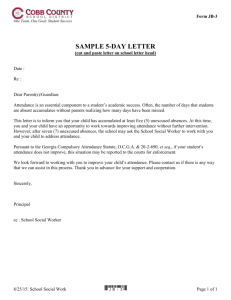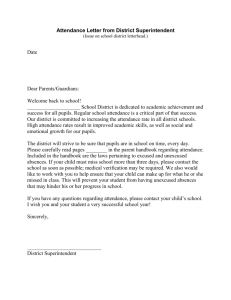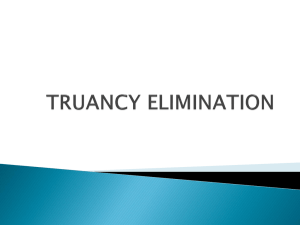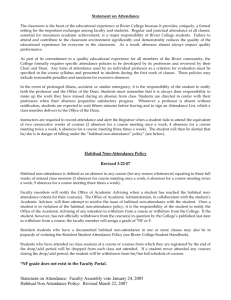New Mexico Compulsory School Attendance
advertisement
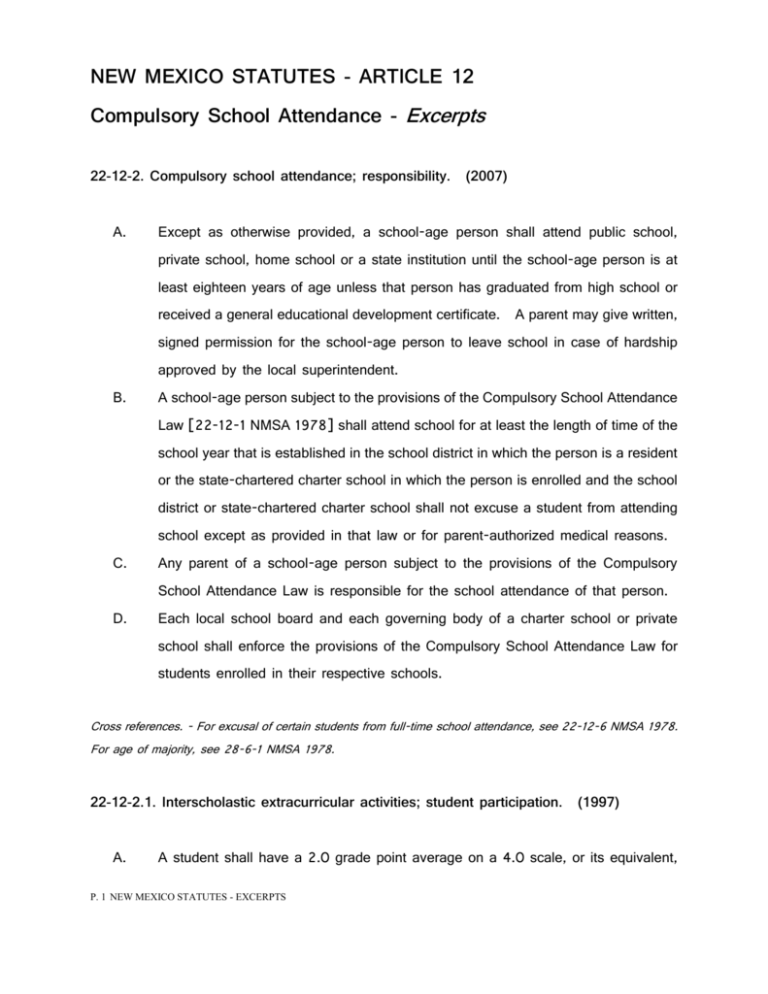
NEW MEXICO STATUTES - ARTICLE 12 Compulsory School Attendance - Excerpts 22-12-2. Compulsory school attendance; responsibility. A. (2007) Except as otherwise provided, a school-age person shall attend public school, private school, home school or a state institution until the school-age person is at least eighteen years of age unless that person has graduated from high school or received a general educational development certificate. A parent may give written, signed permission for the school-age person to leave school in case of hardship approved by the local superintendent. B. A school-age person subject to the provisions of the Compulsory School Attendance Law [22-12-1 NMSA 1978] shall attend school for at least the length of time of the school year that is established in the school district in which the person is a resident or the state-chartered charter school in which the person is enrolled and the school district or state-chartered charter school shall not excuse a student from attending school except as provided in that law or for parent-authorized medical reasons. C. Any parent of a school-age person subject to the provisions of the Compulsory School Attendance Law is responsible for the school attendance of that person. D. Each local school board and each governing body of a charter school or private school shall enforce the provisions of the Compulsory School Attendance Law for students enrolled in their respective schools. Cross references. - For excusal of certain students from full-time school attendance, see 22-12-6 NMSA 1978. For age of majority, see 28-6-1 NMSA 1978. 22-12-2.1. Interscholastic extracurricular activities; student participation. A. (1997) A student shall have a 2.0 grade point average on a 4.0 scale, or its equivalent, P. 1 NEW MEXICO STATUTES - EXCERPTS either cumulatively or for the grading period immediately preceding participation, in order to be eligible to participate in any interscholastic extracurricular activity. For purposes of this section, "grading period" is a period of time not less than six weeks. The provisions of this subsection shall not apply to special education students placed in class C and class D programs. B. No student shall be absent from school for school-sponsored interscholastic extracurricular activities in excess of fifteen days per semester, and no class may be missed in excess of fifteen times per semester. C. The provisions of Subsections A and B of this section apply only to interscholastic extracurricular activities. D. The state superintendent [secretary] may issue a waiver relating to the number of absences for participation in any state or national competition. The state superintendent shall develop a procedure for petitioning cumulative provision eligibility cases, similar to other eligibility situations. E. Student standards for participation in interscholastic extracurricular activities shall be applied beginning with a student's academic record in grade nine. Cross references. - For transfer of powers and duties of the former state superintendent, see 9-24-15 NMSA 1978. 22-12-3. Religious instruction excusal. A student may, subject to the approval of the school principal, be excused from school to participate in religious instruction for not more than one class period each school day with the written consent of the student's parents at a time period not in conflict with the academic program of the school. The local school board or governing body of a charter school, and its school employees, shall not assume responsibility for the religious instruction or permit it to be conducted on school property. Cross references. - For constitutional right to freedom of religion, see N.M. Const., art. II, ' 11. For prohibition against requiring attendance at or participation in religious services by teachers or students, see P. 2 NEW MEXICO STATUTES - EXCERPTS N.M. Const., art. XII,'9. 22-12-4. Right to education. (1978) All school age persons in the state shall have a right to a free public education as follows: A. except for school age persons who are detained or enrolled in state institutions other than those school age persons provided for in Subsection C of this section, any school age person shall have a right to attend public school within the school district in which he resides or is present; B. except as provided in Subsection C of this section, the state institution in which a school age person is detained or enrolled shall be responsible for providing educational services for the school age person; and C. any school age person who is a client as defined in Section 43-1-3 NMSA 1978 in a state institution under the authority of the secretary of the health and environment department shall have a right to attend public school in the school district in which the institution, in which he is a client, is located if: (1) the school age person has been recommended for placement in a public school by the educational appraisal and review committee of the district in which the institution is located; or (2) the school age person has been recommended for placement in a public school as a result of the appeal process as provided in the special education regulations of the state board [department] of education. 22-12-5. School attendance. A. (1990) Local school boards may admit school-age persons who do not live within the school district to the public schools within the school district when there are sufficient school accommodations to provide for them. B. Local school boards may permit school-age persons to transfer to a school outside the child's attendance zone but within the school district when there are sufficient P. 3 NEW MEXICO STATUTES - EXCERPTS school accommodations to provide for them. C. Local school boards may charge a tuition fee for the right to attend public school within the school district only to those school-age persons who do not live within the state. The tuition fee shall not exceed the amount generated by the public school fund for a school-age person similarly situated within the school district for the current school year. D. When the parent or guardian of a student not living in the state pays an ad valorem property tax for school purposes within the district, the amount of the tuition payable for the school year shall be reduced by the district average ad valorem tax per pupil as determined by the ad valorem tax credit utilized in calculating state equalization guarantee distribution. 22-12-7. Enforcement of attendance law; habitual truants; penalty. (2009) A. Each local school board and each governing body of a charter school or private school shall initiate the enforcement of the provisions of the Compulsory School Attendance Law [22-12-1 NMSA 1978] for students enrolled in their respective schools. B. To initiate enforcement of the provisions of the Compulsory School Attendance Law against an habitual truant, a local school board or governing body of a charter school or private school or its authorized representatives shall give written notice of the habitual truancy by mail to or by personal service on the parent of the student subject to and in noncompliance with the provisions of the Compulsory School Attendance Law. The notice shall include a date, time and place for the parent to meet with the local school district, charter school or private school to develop intervention strategies that focus on keeping the student in an educational setting. C. If unexcused absences continue after written notice of habitual truancy as provided in Subsection B of this section has occurred, the student shall be reported to the probation services office of the judicial district where the student resides for an investigation as to whether the student shall be considered to be a neglected child P. 4 NEW MEXICO STATUTES - EXCERPTS or a child in a family in need of services because of habitual truancy and thus subject to the provisions of the Children's Code [32A-1-1 NMSA 1978]. The probation services office may send a written notice to a parent of the student directing the parent and student to report to the probation services office to discuss services for the student or the family. In addition to any other disposition, the children's court may order the habitual truant's driving privileges to be suspended for a specified time not to exceed ninety days on the first finding of habitual truancy and not to exceed one year for a subsequent finding of habitual truancy. D. If, after review by the juvenile probation office where the student resides, a determination and finding is made that the habitual truancy by the student may have been caused by the parent of the student, then the matter will be referred by the juvenile probation office to the district attorney's office or any law enforcement agency having jurisdiction for appropriate investigation and filing of charges allowed under the Compulsory School Attendance Law. Charges against the parent may be filed in metropolitan court, magistrate court or district court. E. A parent of the student who, after receiving written notice as provided in Subsection B of this section and after the matter has been reviewed in accordance with Subsection D of this section, knowingly allows the student to continue to violate the Compulsory School Attendance Law shall be guilty of a petty misdemeanor. Upon the first conviction, a fine of not less than twenty-five dollars ($25.00) or more than one hundred dollars ($100) may be imposed, or the parent of the student may be ordered to perform community service. If violations of the Compulsory School Attendance Law continue, upon the second and subsequent convictions, the parent of the student who knowingly allows the student to continue to violate the Compulsory School Attendance Law shall be guilty of a petty misdemeanor and shall be subject to a fine of not more than five hundred dollars ($500) or imprisonment for a definite term not to exceed six months or both. F. The provisions of this section shall apply beginning July 1, 2004. 22-12-8. Early identification; unexcused absences and truancy. P. 5 NEW MEXICO STATUTES - EXCERPTS (2009) Notwithstanding the provisions of Section 22-12-7 NMSA 1978, if a student is in need of early intervention, the school district, charter school or private school shall contact the student's parent to inform the parent that the student has unexcused absences from school and to discuss possible interventions. The provisions of this section do not apply to any absence if the parent has contacted the school to explain the absence. 22-12-9. Unexcused absences and truancy; attendance policies. A. (2009) As used in this section and Sections 22-12-7 and 22-12-8 NMSA 1978: (1) "habitual truant" means a student who has accumulated the equivalent of ten or more unexcused absences within a school year; (2) "student in need of early intervention" means a student who has accumulated five unexcused absences within a school year; and (3) "unexcused absence" means an absence from school or classes for which the student does not have an allowable excuse pursuant to the Compulsory School Attendance Law [22-12-1 NMSA 1978] or rules of the local school board or governing authority of a charter school or private school. B. An unexcused absence of two or more classes up to fifty percent of an instructional day shall be counted as one-half day absence, and the unexcused absence of more than fifty percent of an instructional day shall be counted as one full-day absence. C. Each school district, and charter school shall maintain an attendance policy that: (1) provides for early identification of students with unexcused absences, students in need of early intervention and habitual truants and provides intervention strategies that focus on keeping students in need of early intervention in an educational setting and prohibit P. 6 NEW MEXICO STATUTES - EXCERPTS out-of-school suspension and expulsion as the punishment for unexcused absences and habitual truancy; (2) uses withdrawal as provided in Section 22-8-2 NMSA 1978 only after exhausting intervention efforts to keep students in educational settings; (3) requires that class attendance be taken for every instructional day in every public school or school program in the school district; and (4) provides for schools to document the following for each student identified as a habitual truant: (a) attempts of the school to notify the parent that the student had unexcused absences; (b) attempts of the school to meet with the parent to discuss intervention strategies; and (c) intervention strategies implemented to support keeping the student in school. D. The department shall review and approve school district and charter school attendance policies. E. School districts and charter schools shall report unexcused absences and habitual truancy rates to the department in a form and at such times as the department determines and shall document intervention efforts made to keep students in need of early intervention and habitual truants in educational settings. Locally chartered charter schools shall provide copies of their reports to the school district. The department shall compile school district and charter school reports on rates of unexcused absences and habitual truancy and require school districts and charter schools to certify that the information is being reported consistently. P. 7 NEW MEXICO STATUTES - EXCERPTS
